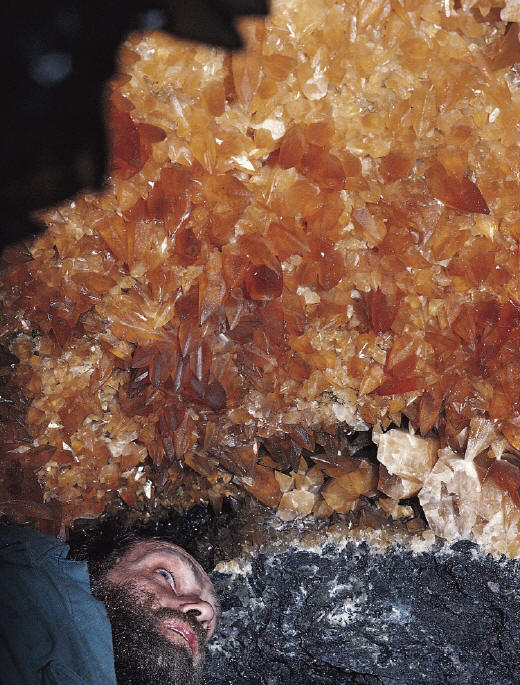
Kenneth Holmgren inside the Butterfly Twin Pocket. P. Lyckberg photo.
During the next week Kenneth duga 3 m long and 70-80 cm wide tunnelthrough solid magnetite with the idea ofaccessing the flower face on. He wasthen going to drill around it with a diamonddrill in order to remove the specimenintact. The last day he was so tiredthat he left the specimen unprotected atthe wall. Unfortunately, he mentionedthis find to a completely inexperiencedminer who went down with his fatherand simply knocked the crystals off thewall! Upon hearing this terrible news,the miner was contacted and asked tohold the crystals for me. After comingback to the mine it turned out that miner had already sold most of the flowerparts. What was really annoying wasthat not only did the miner have no claimto the piece having not discovered it nordone all the work to expose it for easyand safe collecting, he had also promisedto keep the crystals for us, the originaldiscoverers. Over the ensuing years Ihave been buying back the pieces fromthis lost specimen.

Calcite crystal on matrix, 3.3 cm high. P. Lyckberg specimen. J. Scovil photo.
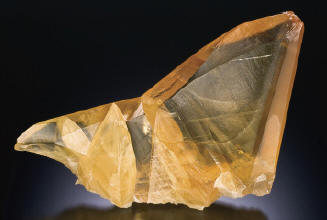
Twinned calcite, 11.2 cm wide. P. Lyckberg specimen. J. Scovil photo.
When work was again started lookingfor extensions of the calcite pocket,it appeared to be in fact a system ofsmall narrow pockets with occasionalcalcite crystallization.
Another miner,Roland B?ckstr?m, known for his instantignition and competing with Kenneth,blasted the rock face to smithereens.
It was depressing to see thousands ofcalcite shards littering the floor. Someof them were certain to have been partsof world-class specimens worthy of anymuseum collection; unfortunately, notmuch survived.
Surprisingly, a very large (17 cm),flawless, gem quality scalenohedron ofcalcite survived the blast. It was found ina small, thin fissure growing from onewall just touching the other wall. Thisgemmy calcite is the finest of its kind andresides in the author’s collection. All togetherless than a dozen exceptionalcrystals were saved while all the othershad broken terminations or were brokenin half or worse. Regrettably, no imageswere made of the Gem Pocket in situ.
After such an impressive find, onecan imagine the rumors that startedamong the locals. Miners talked withfriends, who spoke with other friends,and pretty soon a large cave was foundwith even bigger gemmy calcites! Unfortunately,the rumors being totally untrue,were better than the calcites! On a positivenote, the rumors did spur the minersto search the tunnels for more crystals.
SECOND CALCITE POCKET– THE BUTTERFLY TWIN POCKET
Discovery of the Gem Pocket promptedKenneth to think of other places inthe mine that might have specimen potential.
Years earlier, while loading rocksfrom a blast on the upper level of the same ramp as the Gem Pocket, Kennethhad noted a lot of calcite splinters in themuck. There was too much work to getdone to permit exploring for crystals, soall Kenneth could do was casually makenote of the presence of numerous calcitepockets. Now Kenneth was desperatelysearching both the mine, and the memoriesin his mind for that place with thepotential of more golden calcites. He finallylocated the pocket high up on thewall, close to the ceiling approximately50 m vertically above the Gem Pocket.
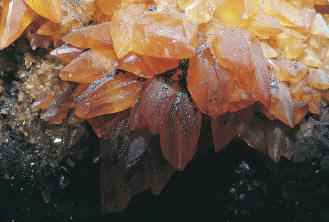
Calcite crystals in situ. P. Lyckberg photo.
This pocket didn’t have such pristinegemmy crystals, but there were verylarge scalenohedrons occurring in thepocket which turned out to be the upperextension of the same fissure zone asthe Gem Pocket. The outer part of thepocket had been sprayed, and partiallycovered by shotcrete (concrete blownup on to mine walls and surfaces forsafety and ground control). Luckilythe entrance to the pocket was verynarrow and bending, thus preventingcomplete covering of the opening by theshotcrete.
Kenneth was able to peek some 2meters into this pocket where he saw 10to 30 cm long, transparent golden crystalshanging from the roof in one cornerof the pocket. On the bottom of the pocketthere was a strange knob of goldencalcite scalenohedrons, some of themwere much larger and very gemmy.
After making this discovery, Kennethimmediately called me up. I almostjumped out of my chair from the descriptionof 10 cm flat calcite crystalslooking like butterflies sitting betweenscalenohedrons! A detailed explanationover the phone about the unique natureof these crystals resulted in a plan toremove half a meter of rock below thepocket before even attempting to removeany specimen. Kenneth was to pay specialattention to protect these “butterflytwins” and remove the specimens in aslarge and intact pieces as possible.
Manynervous phone calls were made, between dreams of what the crystals might looklike in person!
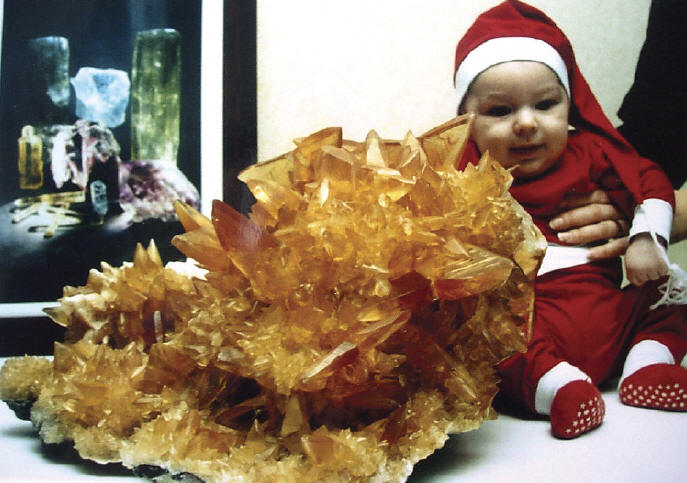
One of the best specimens from the find – so called “Lyckberg Calcite” – photographed with Peter’s son David when he was 3 months old. P. Lyckberg specimen and photo.
Following the recommendation toremove a big part of the wall rock belowthe pocket, Kenneth succeeded in removingthree large specimens, all of themwith several large butterfly twins growingupon calcite scalenohedrons. It shuldbe noted here that most of the large butterflytwins grew at the bottom of thepocket. In fact, most of the twins werefound on a single, half meter sized balllikespecimen at the bottom of the pocket.
Removal of these pieces was complicatedby exceedingly hard rock belowthe pocket.
The largest and finest specimen removed(known now as the “LyckbergCalcite” - eds.) consists of a ball like aggregate45x45x35 cm covered with goldencalcite scalenohedrons. In betweenthe scalenohedrons are 12 gemmy goldenbutterfly twinned calcites up to 12.5cm wide. It looked like a school of butterfliesare just landing on a flower-cladmeadow. It was mined from the pocket located5 m high on a vertical wall, and 1.5meters inside a narrow fissure leading tothe pocket. After hours of removing thehard matrix under the specimen Kennethsuddenly got it loose. This extraordinary specimen was so heavy that he,an exceptionally strong man, said afterhaving lifted it with his arms fully extendedthat he felt it was so heavy thathe would never be able to lift it again.
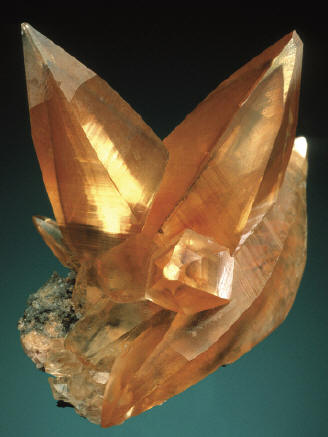
Calcite crystal on matrix, 3.3 cm high. P. Lyckberg specimen. J. Scovil photo








 YueGongAnBei 44051102000467
YueGongAnBei 44051102000467


 |
|